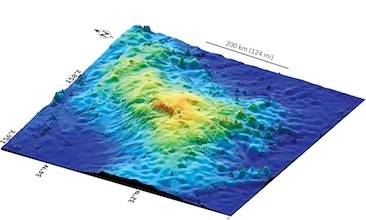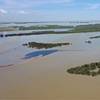Underwater Volcano Dubbed World’s Largest
A University of Houston (UH) professor led a team of scientists to uncover the largest single volcano yet documented on Earth. Covering an area roughly equivalent to the British Isles or the state of New Mexico, this volcano, dubbed the Tamu Massif, is nearly as big as the giant volcanoes of Mars, placing it among the largest in the Solar System.
William Sager, a professor in the Department of Earth and Atmospheric Sciences at UH, first began studying the volcano about 20 years ago at Texas A&M’s College of Geosciences. Sager and his team’s findings appear in the Sept. 8 issue of Nature Geoscience, the monthly multi-disciplinary journal reflecting disciplines within the geosciences.
Located about 1,000 miles east of Japan, Tamu Massif is the largest feature of Shatsky Rise, an underwater mountain range formed 130 to 145 million years ago by the eruption of several underwater volcanoes. Until now, it was unclear whether Tamu Massif was a single volcano, or a composite of many eruption points. By integrating several sources of evidence, including core samples and data collected on board the JOIDES Resolution research ship, the authors have confirmed that the mass of basalt that constitutes Tamu Massif did indeed erupt from a single source near the center.
“Tamu Massif is the biggest single shield volcano ever discovered on Earth,” Sager said. “There may be larger volcanoes, because there are bigger igneous features out there such as the Ontong Java Plateau, but we don't know if these features are one volcano or complexes of volcanoes.”
Tamu Massif stands out among underwater volcanoes not just for its size, but also its shape. It is low and broad, meaning that the erupted lava flows must have traveled long distances compared to most other volcanoes on Earth. The seafloor is dotted with thousands of underwater volcanoes, or seamounts, most of which are small and steep compared to the low, broad expanse of Tamu Massif.
“It’s not high, but very wide, so the flank slopes are very gradual,” Sager said. “In fact, if you were standing on its flank, you would have trouble telling which way is downhill. We know that it is a single immense volcano constructed from massive lava flows that emanated from the center of the volcano to form a broad, shield-like shape. Before now, we didn't know this because oceanic plateaus are huge features hidden beneath the sea. They have found a good place to hide.”
Tamu Massif covers an area of about 120,000 square miles. By comparison, Hawaii’s Mauna Loa – the largest active volcano on Earth – is approximately 2,000 square miles, or roughly 2 percent the size of Tamu Massif. To find a worthy comparison, one must look skyward to the planet Mars, home to Olympus Mons. That giant volcano, which is visible on a clear night with a good backyard telescope, is only about 25 percent larger by volume than Tamu Massif.
The study relies on two distinct, yet complementary, sources of evidence – core samples collected on Integrated Ocean Drilling Program (IODP) Expedition 324 (Shatsky Rise Formation) in 2009, and seismic reflection data gathered on two separate expeditions of the R/V Marcus G. Langseth in 2010 and 2012. The core samples, drilled from several locations on Tamu Massif, showed that thick lava flows (up to 75 feet thick), characterize this volcano. Seismic data from the R/V Langseth cruises revealed the structure of the volcano, confirming that the lava flows emanated from its summit and flowed hundreds of miles downhill into the adjacent basins.
According to Sager, Tamu Massif is believed to be about 145 million years old, and it became inactive within a few million years after it was formed. Its top lies about 6,500 feet below the ocean surface, while much of its base is believed to be in waters that are almost four miles deep.
“It’s shape is different from any other sub-marine volcano found on Earth, and it’s very possible it can give us some clues about how massive volcanoes can form,” Sager said. “An immense amount of magma came from the center, and this magma had to have come from the Earth’s mantle. So this is important information for geologists trying to understand how the Earth’s interior works.”
The project was funded by the National Science Foundation, both through direct grants and through its Integrated Ocean Drilling Program, an international research program dedicated to advancing scientific understanding of the Earth through drilling, coring and monitoring the subsea floor.
uh.edu














